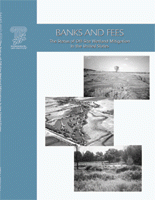
The face of mitigation banking has changed substantially over the past 10 years'from a small industry dominated by state and local governments to a quickly growing nationwide commercial enterprise dominated by entrepreneurs, according to a report released by the Environmental Law Institute. Based on a two-year study of off-site compensatory mitigation, Banks and Fees: The Status of Off-Site Wetland Mitigation in the United States, describes and analyzes wetland mitigation banks, in-lieu-fee mitigation, and umbrella banks, and recommends opportunities for improving their effectiveness.
Although permittee-responsible mitigation remains the dominant form of compensatory mitigation, the use of mitigation banks to restore, create, enhance, or preserve wetlands as compensation for permitted wetland impacts under section 404 of the Clean Water Act has considerably increased over the past decade. The 2002 study documents 219 approved banks — a 376 percent increase of banks in the country since 1992. At least another 95 banks are pending approval. In the early 1990s, nearly 75 percent of the nation?s existing banks were single-user banks sponsored by state or local governments with only one private commercial bank in operation. Today, of the 214 approved banks analyzed, 135 are private commercial banks and 61 are single-user banks.
ELI?s study also identified all of the in-lieu-fee programs in the country. Currently 87 active in-lieu-fee programs in 27 states are administered by the Corps, or by state or local government. However, a significant number of in-lieu-fee programs fail to adequately document their activities.
Wetland mitigation banking, in-lieu-fee mitigation, and mitigation banking approved under umbrella agreements all hold great promise for improving the effectiveness of compensatory mitigation. The study makes available to the public information on the location and character of these sites with the hope that the data will help local groups get involved in incorporating local concerns into mitigation siting and design.